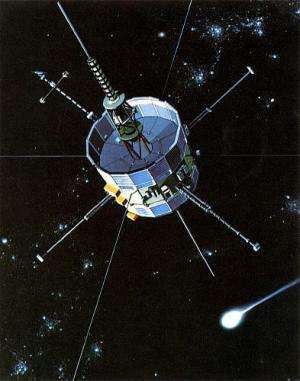Space buffs hope to reawaken old NASA probe

When NASA launched a space-weather probe called ISEE-3 in 1978, Jimmy Carter was president, the Commodores' "Three Times a Lady" topped the charts and sci-fi fans had seen only one "Star Wars" movie: the original.
Thirty-six years and five "Star Wars" movies later, the NASA craft, unused by the agency since 1997, is again the talk of the space world.
A group of garage engineers - ranging from a 23-year-old former University of Central Florida student to an 81-year-old ex-NASA official - wants to get the bookshelf-sized probe working again when it whips by the moon this summer.
The aim is to restart its mission of monitoring space weather and - if the group can pull it off - send it to study an incoming comet in 2018.
"This is something that has never been done before," said Robert Farquhar, a former NASA manager who worked with the spacecraft in the 1980s.
But waking a NASA probe in space for nearly four decades is no easy task. Not only do team members have to figure out how to "talk" to the spacecraft and give it commands, but they'll also have to do it without NASA funding.
NASA is helping the campaign by releasing related documents, but the cash-strapped agency isn't spending any money on the project. Dwayne Brown, a NASA spokesman, said in a statement that "re-contacting ISEE-3 would have little scientific value" for NASA.
Still, supporters argue that any new data could be helpful and that reviving the craft could help get the public excited about space. That's why the team is trying to crowd-fund the project - having so far raised about 60 percent of the goal of $125,000.
The "vast majority of the donations are $10 or $50, (but) pocket change in large numbers can turn into something," said Keith Cowing, editor of the NASAWatch website and one of the project's directors.
Adding to the pressure is lack of time. Unless the team can get the probe working again by mid-June - and alter its current flight path - the spacecraft will sail by the moon in August and disappear into space. It won't come close to Earth again until 2029, said Dennis Wingo, another project director.
"It's do or die," Wingo said. "Every day is precious. Every hour is precious right now."
It's a strange new chapter for a spacecraft last seen on Earth on Aug. 12, 1978, the day NASA launched ISEE-3 from Cape Canaveral Air Force Station on a mission to study space weather.
NASA wanted to better understand solar wind and how it interacted with Earth's magnetic field, so ISEE-3 was dispatched to a stable orbit about 930,000 miles from Earth to take measurements. Equipped with instruments advanced for the time, ISEE-3 gathered data "at the rate of once every 40 minutes," according to NASA - about 10,000 times slower than current spacecraft.
A few years into that initial mission, however, NASA officials, including Farquhar, commandeered the craft for an entirely different mission: chasing comets. So in the early 1980s, NASA fired the spacecraft's thrusters and sent it to follow a comet known as Giacobini-Zinner.
The hunt was successful, and in 1985 the craft made history by becoming the first probe to fly past a comet - getting as close as 5,000 miles from the core of Giacobini-Zinner. There it made measurements that confirmed scientists' suspicions that comets essentially were space's "dirty snowballs": fast objects comprised of ice, rock and gases.
A year later, ISEE-3 did a similar flyby of Halley's Comet and afterward spent several years studying the sun until NASA stopped operating it in 1997.
But the spacecraft remained "alive," albeit barely. A 2008 test found ISEE-3 was still sending out signals, and subsequent tests in recent weeks have come to the same conclusion.
Still, the team says there's a major difference between "hearing" signals from the spacecraft and transmitting commands that would allow the probe to fire its thrusters and change course.
So Cowing, Wingo and volunteers nationwide have been scouring old NASA documents to gain a better understanding of how the spacecraft works and how to control it.
Jacob Gold is part of the effort. The former University of Central Florida student said he has been developing a virtual model of ISEE-3.
His computer image will allow the team members to test the power and timing of the craft's maneuvers so that when the time comes, they can set it on the right course. He's also helping to rebuild the craft's "mission control" center, which - in a sign of how far technology has come - will total as few as two or three computers.
"I'm actually pretty optimistic about this working," said Gold, who grew up in the South Florida city of Weston and is now attending the University of Arizona studying aerospace engineering. "It's by no means guaranteed. But we have a lot of good people on the project, and we are getting tremendous support from the Internet community."
©2014 The Orlando Sentinel (Orlando, Fla.)
Distributed by MCT Information Services




















